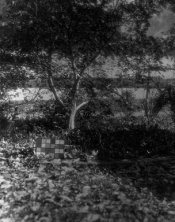Photo Engineer
Subscriber
I have now repeated the film emulsion on paper and film support at 3 workshops and about 6 times alone. All the results indicate that the film speed is about 25 to 50 and the paper speed is about 100 - 200 with significantly higher fog.
The higher speed and fog on paper is normal due to back reflection and the relative coated silver levels.
Now, here are the problems as I see them:
1. Contrast and Dmax vary and are much too low. There is too much unused silver and I have to fix that.
2. There is too much variation in contrast, dmax and fog from coating to coating and batch to batch.
3. Under magnification there is a slight appearance of specks. These are not pepper grain, as they are colorless and are not present in fixed out stock. I believe it is just darkroom grunge and I need to use a finer filter for the emulsion before coating and just patiently wait for the thick emulsion to run through the filter.
4. This is an SRAD (Single Run Ammonia Digest) emulsion and the smell of ammonia during digestion is so strong even in a large darkroom that it is hard to make large batches. The small batch size may be contributing to the overall variability.
5. The chemical sensitization and the digestion take too long to get the speed I want.
6. I am starting to run out of transparent subbed support, and may have to find another source for continuing these experiments. My thanks to Jim Browning for the supply that I do have.
Therefore, I am going to revisit this emulsion and try for a better design that uses another solvent than ammonia for digestion and a better workup method than the one presently used. My speed aim will remain in the ISO 50 speed range and the sensitivity aim will remain orthochromatic. The results to date do not seem to suffer from a lack of sharpness or any problems associated with having no AH layer, but I do have the dye for addressing this problem.
I may have to continue this work making paper negatives for a while to conserve film support and only make film coatings when I know things have been 'fixed'.
PE
The higher speed and fog on paper is normal due to back reflection and the relative coated silver levels.
Now, here are the problems as I see them:
1. Contrast and Dmax vary and are much too low. There is too much unused silver and I have to fix that.
2. There is too much variation in contrast, dmax and fog from coating to coating and batch to batch.
3. Under magnification there is a slight appearance of specks. These are not pepper grain, as they are colorless and are not present in fixed out stock. I believe it is just darkroom grunge and I need to use a finer filter for the emulsion before coating and just patiently wait for the thick emulsion to run through the filter.
4. This is an SRAD (Single Run Ammonia Digest) emulsion and the smell of ammonia during digestion is so strong even in a large darkroom that it is hard to make large batches. The small batch size may be contributing to the overall variability.
5. The chemical sensitization and the digestion take too long to get the speed I want.
6. I am starting to run out of transparent subbed support, and may have to find another source for continuing these experiments. My thanks to Jim Browning for the supply that I do have.
Therefore, I am going to revisit this emulsion and try for a better design that uses another solvent than ammonia for digestion and a better workup method than the one presently used. My speed aim will remain in the ISO 50 speed range and the sensitivity aim will remain orthochromatic. The results to date do not seem to suffer from a lack of sharpness or any problems associated with having no AH layer, but I do have the dye for addressing this problem.
I may have to continue this work making paper negatives for a while to conserve film support and only make film coatings when I know things have been 'fixed'.
PE












 to see what you thought of them.
to see what you thought of them. 
